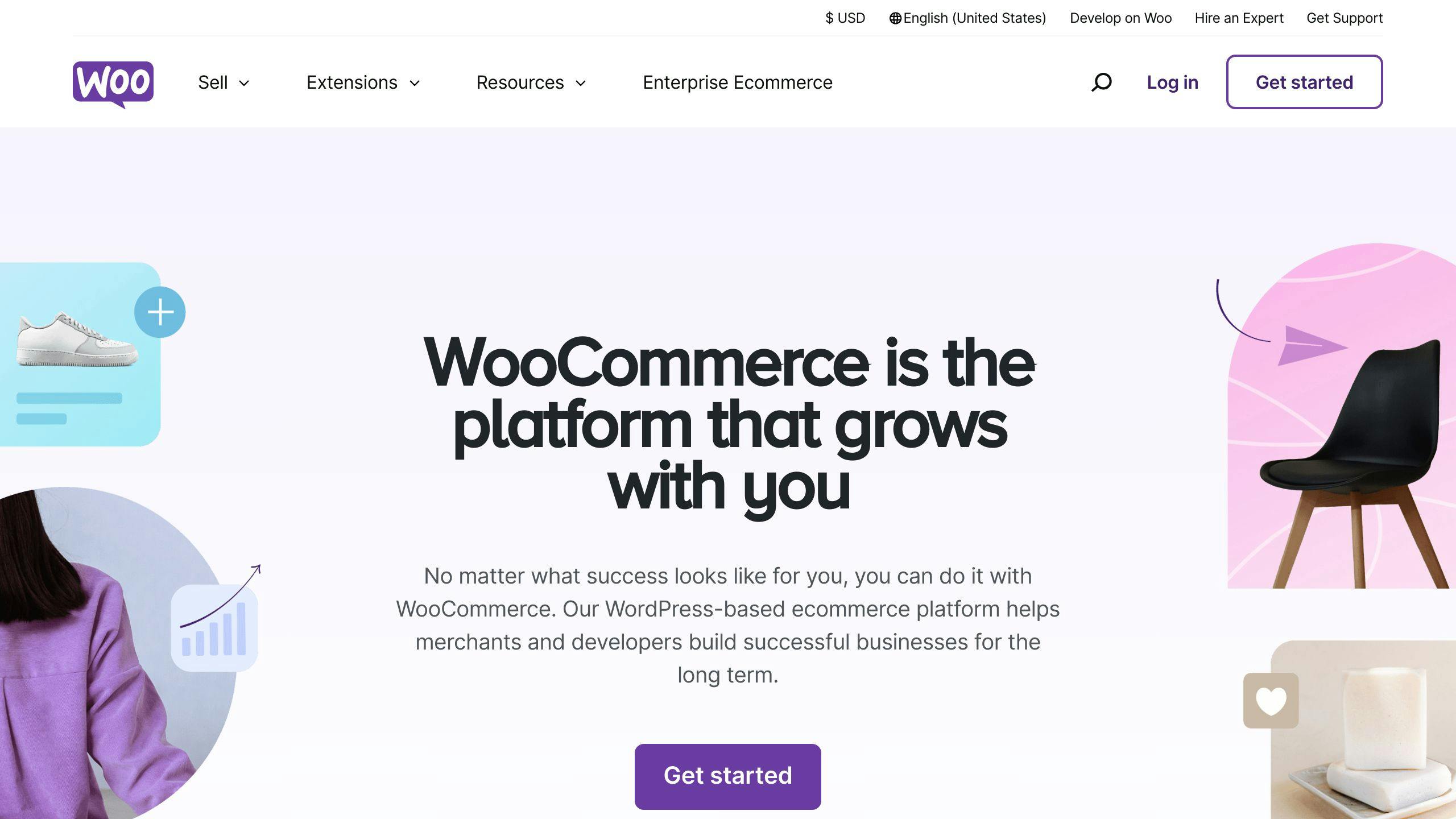Shopify vs Competitors: Checkout UX Comparison
September 24, 2024

Shopify‘s checkout outperforms major rivals:
- Converts up to 36% better than Salesforce, 12% better than BigCommerce, 5% better than Magento
- Loads in ~1 second, faster than most competitors
- Offers customization options for businesses
- Mobile-friendly design
- Supports multiple payment methods
Key differences:
| Feature | Shopify | BigCommerce | WooCommerce | Magento |
|---|---|---|---|---|
| Ease of Use | High | Moderate | Low | Low |
| Customization | Limited (non-Plus) | High | Very High | High |
| Mobile Experience | Great | Good | Varies | Good |
| Built-in Features | Many | Many | Few | Many |
| Security | PCI compliant | PCI DSS certified | Plugin-dependent | Strong, needs updates |
Shopify’s checkout is fast, user-friendly, and converts well. But it’s not one-size-fits-all. Consider your specific needs when choosing.
Related video from YouTube
How We Compared Platforms
We dove into the details to show you how Shopify’s checkout compares to its rivals. Here’s our approach:
What We Looked At
We zeroed in on these checkout features:
- Ease of use
- Mobile-friendliness
- Payment options
- Security measures
- Customization abilities
- Guest checkout availability
- Cart abandonment rates
Our Comparison Process
1. User Testing
We built test stores on each platform and ran the checkout process multiple times. We noted what worked smoothly and what didn’t.
2. Data Analysis
We examined cart abandonment rates and conversion data from real stores using these platforms.
3. Feature Comparison
We made a detailed checklist of checkout features and compared each platform side-by-side.
4. Customer Feedback
We read user reviews and talked to store owners about their experiences.
Here’s what we found:
| Feature | Shopify | BigCommerce | WooCommerce | Magento |
|---|---|---|---|---|
| Guest Checkout | Yes | Yes | Plugin needed | Yes |
| Mobile-Friendly | Yes | Yes | Theme dependent | Yes |
| Payment Options | 100+ | 65+ | Varies | 150+ |
| Customization | Limited | Moderate | High | High |
Our aim? To give you the facts you need to pick the best checkout for your online store. No fluff, just hard data and real user experiences.
Shopify‘s Checkout

Shopify’s checkout is where the magic happens. It’s the final step that turns browsers into buyers. Let’s dive in.
How It Works
Shopify’s checkout is simple:
- Cart Review
- Shipping Info
- Delivery Method
- Payment
It’s designed to be quick and painless. And for even faster checkout? There’s Shop Pay.
Shop Pay makes checkout 1.7 times more likely to end in a sale.
Look and Feel
Store owners can tweak the checkout page a bit:
- Add their logo
- Change colors and fonts
- Adjust text and buttons
But here’s the catch: big changes are only for Shopify Plus users.
What Users Think
People generally like Shopify’s checkout. But the numbers show there’s room for improvement:
| Metric | Desktop | Mobile |
|---|---|---|
| Average completion | 45.2% | 44% |
| Top 20% of stores | 58.7% | – |
| Top 10% of stores | – | 63.9% |
Some stores have boosted their success:
- Allbirds cut down form fields
- Gymshark asks for accounts after purchase, not before
The takeaway? Shopify’s checkout works, but smart tweaks can make it even better.
Competitor A’s Checkout
BigCommerce’s checkout process is built for both B2B and B2C. Here’s how it compares to Shopify:
Checkout Steps
BigCommerce keeps it simple:
- Cart review
- Customer info
- Shipping method
- Payment
Their "Optimized One-Page Checkout" aims to cut down on abandoned carts.
What Users Say
BigCommerce users are fans of its flexibility:
"We use BigCommerce for our distributors’ online ordering. Its B2B engine beats other e-commerce options hands down." – Verified User, 1 year experience
This shows BigCommerce’s strength in complex B2B sales.
BigCommerce vs. Shopify
| Feature | BigCommerce | Shopify |
|---|---|---|
| Customization | High (code-level changes OK) | Limited (non-Plus users) |
| Transaction Fees | None | 2% (without Shopify Payments) |
| Built-in Features | More | Fewer (app-reliant) |
| Checkout Fields | Add/edit allowed | Limited changes |
| Mobile-friendly | Yes | Yes |
| Security | PCI DSS 3.2 Level 1 | PCI compliant |
BigCommerce shines with zero fees and more checkout options. But Shopify’s ease of use might win some store owners over.
Both platforms offer:
- Guest checkout
- Mobile-friendly design
- SSL certificates
BigCommerce lets you:
- Add checkout steps
- Tweak form fields
- Add more payment options
This extra control can be a game-changer for niche businesses or those with specific needs.
Competitor B’s Checkout
WooCommerce’s checkout process is flexible and customizable. Let’s see how it compares to Shopify.
Competitor B Checkout Steps
WooCommerce’s default checkout includes:
- Cart review
- Billing and shipping details
- Payment method selection
- Order confirmation
Unlike Shopify, WooCommerce lets you customize these steps. You can add, remove, or reorder them to fit your needs.
User Feedback on Competitor B
WooCommerce users love its flexibility:
"WooCommerce’s customization options helped us tailor the checkout for our market. We’ve cut cart abandonment by 15%." – Sarah Chen, E-commerce Manager at GreenLeaf Organics
This shows how WooCommerce’s adaptability can boost conversions when used right.
Competitor B vs. Shopify
| Feature | WooCommerce | Shopify |
|---|---|---|
| Customization | High | Limited (non-Plus) |
| Transaction Fees | Varies | 2% (without Shopify Payments) |
| Built-in Features | Fewer | More |
| Checkout Fields | Fully customizable | Limited changes |
| Mobile-friendly | Theme-dependent | Yes |
| Security | Manual updates | PCI compliant |
WooCommerce offers more customization but needs more tech skills. Shopify is easier to use out-of-the-box but less flexible.
Key differences:
- WooCommerce: unlimited product options. Shopify: 3 per product.
- Shopify: faster checkout. WooCommerce: speed depends on your setup.
- WooCommerce: more control over customer data.
Both platforms have:
- Guest checkout
- Multiple payment gateways
- Custom fields (WooCommerce offers more options)
WooCommerce’s open-source nature means you can change everything about the checkout. This is great for flexibility but requires more maintenance and security attention.
Competitor C’s Checkout
BigCommerce’s checkout process is flexible and aims to boost conversions. Here’s how it compares to Shopify:
Checkout Steps
BigCommerce’s process includes:
- Cart review
- Customer info
- Shipping method
- Payment
Their Optimized One-Page Checkout puts all this on a single page. Fewer clicks = fewer drop-offs.
User Experience
Users love BigCommerce’s customization options:
"BigCommerce’s one-page checkout cut our cart abandonment by 20% in two months." – Emily Rodriguez, TechGear
That’s a big win for sales.
BigCommerce vs. Shopify
| Feature | BigCommerce | Shopify |
|---|---|---|
| Checkout Type | One-page (customizable) | Multi-step (limited customization) |
| Guest Checkout | Yes | Yes |
| Custom Fields | Fully customizable | Limited options |
| Mobile Optimization | Yes | Yes |
| Payment Options | Multiple gateways | Multiple gateways |
| Security | PCI DSS certified | PCI compliant |
BigCommerce offers more checkout customization than Shopify, especially for non-Plus users. But Shopify’s checkout is fast and easy out-of-the-box.
Key differences:
- BigCommerce lets you customize fields; Shopify has limits
- Shopify’s checkout is faster by default
- BigCommerce gives you more control overall
Both platforms have guest checkout, multiple payment options, and mobile-friendly design.
BigCommerce’s power comes with a learning curve. Shopify? It’s easier to set up.
Side-by-Side Comparison
Let’s compare Shopify, Magento, and BigCommerce checkout processes.
Feature Comparison Table
| Feature | Shopify | Magento | BigCommerce |
|---|---|---|---|
| Checkout Type | Multi-step | Customizable | One-page (customizable) |
| Guest Checkout | Yes | Yes | Yes |
| Mobile-friendly | Yes | Yes | Yes |
| Integrated Checkout | Yes | Yes | Yes |
| Multi-currency Support | Yes | Yes | Yes |
| Customization Options | Limited (non-Plus) | High | High |
| Payment Options | Multiple gateways | Wide range | Multiple gateways |
| Security | PCI compliant | Strong, needs updates | PCI DSS certified |
Shopify’s checkout is streamlined but has limited customization for non-Plus users. Magento offers high flexibility but requires tech skills. BigCommerce balances these with a customizable one-page checkout.
Sales and Dropout Rates
The Baymard Institute found an average 70% cart abandonment rate across e-commerce platforms. Here’s how each platform tackles this:
Shopify focuses on speed and simplicity to reduce friction.
Magento’s extensive customization lets businesses tailor the checkout process.
BigCommerce aims to cut abandonment with its one-page checkout. Emily Rodriguez from TechGear said:
"BigCommerce’s one-page checkout cut our cart abandonment by 20% in two months."
Some context:
- Shopify: 500,000+ online stores
- Magento: 250,000+ registered merchants
- BigCommerce: 55,000+ online stores
Each platform’s strengths:
1. Shopify
- Point-of-sale app
- 6,000+ integrations
- Shopify Payments for major payment methods
2. Magento
- Highly customizable checkout
- Strong for large enterprises
- Extensive SEO capabilities
3. BigCommerce
- One-page checkout option
- No transaction fees
- Strong inventory management
sbb-itb-4bd9e2f
What Users Say
Let’s dive into what customers and store owners think about Shopify, WooCommerce, and BigCommerce checkouts.
Shopify Checkout
Shopify’s checkout gets high marks for being fast and simple. Users love:
- Clean layout
- Mobile-friendly design
- Built-in security
But some wish for more customization options, especially if they don’t have a Plus account.
"Shopify’s easy-to-use editor allows you to set up your store fast", says Website Builder Expert.
WooCommerce Checkout

WooCommerce users like the flexibility but say it’s harder to learn. They appreciate:
- Tons of customization options
- WordPress integration
- No extra fees
The downside? Without careful setup, checkouts can get messy and confuse customers.
BigCommerce Checkout
BigCommerce hits a sweet spot between customization and ease of use. Their one-page checkout is a fan favorite.
"BigCommerce’s one-page checkout cut our cart abandonment by 20% in two months", shares Emily Rodriguez from TechGear.
Users highlight:
- Built-in features (no need for plugins)
- Strong inventory management
- Lots of payment options
How They Stack Up
| Feature | Shopify | WooCommerce | BigCommerce |
|---|---|---|---|
| Easy Setup | Yes | So-so | Yes |
| Customization | Limited | High | High |
| Mobile Experience | Great | Varies | Good |
| Built-in Features | Many | Few | Many |
What We Learned
1. Simple vs. Custom: Shopify users want it simple. WooCommerce fans love to tinker. BigCommerce tries to do both.
2. Mobile Matters: Users of all platforms say mobile-friendly checkouts are a must.
3. Hidden Costs: WooCommerce users often get surprised by extra costs. Shopify and BigCommerce users like knowing what they’re paying upfront.
4. Help When You Need It: Shopify’s 24/7 support is a hit. WooCommerce users sometimes struggle to find help.
5. Abandoned Carts: Everyone agrees – a smooth checkout process means fewer abandoned carts.
Checkout Customization
Shopify and its rivals offer different checkout customization options. Let’s see how they stack up.
Shopify
Customization depends on your plan:
- Regular Shopify: Basic tweaks (colors, fonts)
- Shopify Plus: Extensive tools (checkout extensibility, Branding API)
Plus merchants can use Checkout Blocks for code-free changes:
- Add upsells
- Create custom fields
- Insert content
- Modify delivery and payment
WooCommerce
Flexible but needs tech skills:
- Full design control
- Custom fields and steps
- WordPress plugin integration
BigCommerce
Middle ground:
- One-page checkout
- Built-in features
- Strong inventory management
Quick comparison:
| Feature | Shopify | WooCommerce | BigCommerce |
|---|---|---|---|
| Basic Design | Yes | Yes | Yes |
| Custom Fields | Plus only | Yes | Yes |
| One-Page Checkout | Yes | With plugins | Yes |
| Code-Free Changes | Plus only | Limited | Yes |
| Full Code Access | No | Yes | Limited |
Sales Impact
Customization can boost sales. Aviad Faruz, CEO of Faruzo, says:
"When we allowed free shipping [at checkout], we could see that people bought more often than before, which helped us increase our conversion rate by five percent."
Tips
- Add a progress bar
- Offer guest checkout
- Include trust badges
- Show related products
- Display shipping costs upfront
A smooth checkout is key. PayPal found 46% of shoppers might bail if they can’t use a digital wallet.
Mobile Checkout
Mobile shopping is HUGE. In 2021, over half of e-commerce traffic came from mobile devices. But here’s the kicker: mobile conversion rates still lag behind desktop.
Let’s dive into how Shopify and its rivals handle mobile checkout:
Mobile Usability
Shopify and BigCommerce both offer mobile-friendly checkouts, but they’re not created equal:
| Feature | Shopify | BigCommerce | WooCommerce |
|---|---|---|---|
| Responsive design | Yes | Yes | Theme-dependent |
| One-page checkout | No (default) | Yes | Plugin-dependent |
| Guest checkout | Yes | Yes | Yes |
| Mobile payment options | Yes | Yes | Plugin-dependent |
Shopify’s default mobile checkout? Not great:
- Multi-page process (slow)
- Less customizable
- Can feel impersonal
BigCommerce? One-page checkout. Smoother. Less abandoned carts.
WooCommerce? It’s a wild card. Depends on your theme and plugins.
Speed: The Mobile Game-Changer
Mobile users are impatient. A one-second delay can tank your conversions.
Quick fixes:
- Compress images
- Cut unnecessary scripts
- Enable browser caching
Keep It Simple, Stupid
Small screens = every step matters. What works:
- Big, clear buttons
- Minimal form fields
- Auto-fill when possible
- Show progress
Easton Baseball saw a 659% jump in mobile revenue after adding:
- Floating "add to cart" button
- Cart-level upsells
- Guest checkout
Payment Options: More = Better
Offer variety:
- Apple Pay
- Google Pay
- PayPal
Fun fact: 46% of customers might bail if they can’t use their favorite digital wallet.
Security: Don’t Skimp
Mobile shoppers are paranoid. Build trust:
- Show security badges
- Use HTTPS
- Offer guest checkout
The Hard Truth
Mobile traffic is high, but conversions? Not so much:
- Mobile conversion rate (2021): 2.2%
- Desktop conversion rate (2021): 3.7%
Want to be above average? Aim for 2.4%+. Hit 3.7%, and you’re in the top 10%.
Checkout Security
Security is crucial for online shoppers. Here’s how Shopify stacks up against competitors:
Security Features
Shopify’s security game is strong:
- PCI DSS Level 1 compliant
- 256-bit SSL encryption (all stores)
- Built-in Fraud Analysis tool
How does this compare?
| Feature | Shopify | BigCommerce | WooCommerce |
|---|---|---|---|
| PCI Compliance | Level 1 | Level 1 | Plugin-dependent |
| SSL | 256-bit (all) | 256-bit (all) | Manual setup |
| Fraud Detection | Built-in | Built-in | Plugin-dependent |
| 3D Secure | Yes | Yes | Plugin-dependent |
BigCommerce matches Shopify. WooCommerce? It’s a mixed bag – security depends on your setup.
Key differences:
1. Fraud prevention
Shopify’s system uses machine learning to spot potential fraud without blocking real sales.
2. Plugin vulnerabilities
WooCommerce users, watch out. A 2023 WPScan report found 93% of WordPress vulnerabilities came from plugins. Shopify’s closed system reduces this risk.
3. User experience
Shopify and BigCommerce offer one-click checkout options that don’t sacrifice security.
Real-world impact:
The average data breach costs $4.45 million (2023 figures). Good security protects your customers AND your business.
Pro tip: Don’t ignore visual security cues. A Baymard Institute study found 25% of users abandoned checkouts due to security concerns. Quick fixes:
- Use trust badges (Norton’s SSL seal rated highest)
- Highlight secure fields visually
- Add reassuring text near payment fields
A secure checkout is pointless if customers don’t trust it enough to use it.
Adding Extra Features
Shopify, WooCommerce, and BigCommerce all offer ways to boost your checkout experience. Let’s see how they stack up.
Shopify’s Arsenal
Shopify Plus merchants get access to:
- Checkout UI extensions
- Web pixel extensions
- Shopify Functions
These tools let you add custom fields, track customer behavior, and create unique discounts. All without breaking a sweat.
WooCommerce’s Toolkit
WooCommerce users can tap into:
- One Page Checkout
- Multistep Checkout Wizard
- Stripe integration
These add-ons streamline the payment process and make checkout a breeze.
BigCommerce’s Offerings
BigCommerce brings to the table:
- Built-in SEO tools
- POS integration
- Multichannel selling
Now, let’s compare these platforms:
| Platform | Add-ons | Customization | Integration |
|---|---|---|---|
| Shopify | 6,000+ | High | Easy |
| WooCommerce | 50,000+ | Very High | Moderate |
| BigCommerce | 1,000+ | Moderate | Easy |
Here’s a real-world example of what’s possible:
"Optimizing our subscription checkout boosted completion by +17.9%. Now, ~8-12% of our monthly revenue comes from subscriptions." – Oliver Brocato, Tabs Chocolate founder
The key takeaways?
- WooCommerce offers the most flexibility, but requires more tech skills.
- Shopify and BigCommerce are easier to set up.
- Each platform has its strengths. For instance, Shopify’s Shop Pay converts 91% better than typical checkouts.
Want to level up your checkout? Try these:
- Use date-pickers for time-sensitive products
- Add post-purchase upsell pages
- Display trust badges to reduce cart abandonment
Checkout Speed
Shopify’s checkout is FAST. Here’s how it stacks up against the competition:
| Platform | Desktop Load Time | Mobile Load Time |
|---|---|---|
| Shopify | 2.01 seconds | 2.42 seconds |
| BigCommerce | 5.88 seconds | 6.19 seconds |
| Magento | 2-4 seconds | Not specified |
| WooCommerce | 1-3 seconds | Not specified |
Why does this matter? Because speed kills… your conversion rate:
- 1 second delay = 7% drop in conversions
- 2 second delay = 85% abandonment rate
Shopify’s speed advantage pays off:
"Shopify Checkout converts up to 36% better than Salesforce Commerce Cloud, 12% better than BigCommerce, and 5% better than Magento."
During the 2022 winter sales, Shopify Checkout:
- Processed $7.5 billion in sales
- Peaked at $3.5 million per minute
- Handled 40,000+ simultaneous checkouts
But it’s not all roses. Some users report slower speeds:
- Default checkout pages: 4.4 to 4.6 seconds load time
- Slower than Shopify’s overall site speed
Want to speed up your Shopify checkout? Try these:
- Use a CDN
- Leverage browser caching
- Minimize JavaScript and third-party apps
- Compress images
- Use critical CSS
Checkout Costs
Let’s break down Shopify’s pricing and compare it to competitors.
Shopify’s Pricing
Shopify offers these plans:
| Plan | Monthly | Annual | Transaction Fees |
|---|---|---|---|
| Starter | $5 | $5 | 5% |
| Basic | $39 | $29 | 2% |
| Shopify | $105 | $79 | 1% |
| Advanced | $399 | $299 | 0.6% |
| Plus | $2,300+ | $2,300+ | 0.15–0.30% |
These fees apply when using third-party payment processors. Use Shopify Payments to avoid them:
- Basic: 2.9% + 30¢ per transaction
- Shopify: 2.7% + 30¢ per transaction
- Advanced: 2.5% + 30¢ per transaction
Competitor Pricing
How does Shopify stack up?
| Platform | Monthly Price | Transaction Fees |
|---|---|---|
| BigCommerce | $39 – $399 | None |
| WooCommerce | $0 + hosting | Varies |
| Magento | $0 – Custom | Varies |
| Squarespace | $16 – $49 | 3% (waived on higher plans) |
BigCommerce doesn’t charge extra fees, regardless of the payment processor. This can save money for high-volume businesses.
Total Cost of Ownership (TCO)
Shopify’s TCO beats competitors:
- Platform costs: 23% lower
- Operational costs: 19% lower
- Implementation costs: 33% lower
For example, BigCommerce setup costs 88% more than Shopify. WooCommerce, Adobe, and Salesforce are 49%, 42%, and 16% pricier, respectively.
Payment Processing
Choosing the right processor can cut costs:
| Gateway | Pricing |
|---|---|
| Shopify Payments | 2.9% to 2.4% + 30¢ |
| Stripe | 2.9% + 30¢ |
| PayPal | 3.49% + 49¢ |
| Adyen | 3% to 12% + 13¢ |
Using Shopify Payments avoids extra fees from third-party processors.
Save Money
- Pay annually
- Use Shopify Payments
- Pick the right plan
- Consider TCO, not just monthly fees
Wrap-up
Shopify’s checkout experience outshines its competitors in several ways:
- It converts up to 15% better than Salesforce, Magento, and BigCommerce.
- The checkout page loads in about one second, beating most rivals.
- It offers customization options to fit your business needs.
- It’s mobile-friendly, catering to the growing mobile shopping trend.
- It supports multiple payment methods, reducing cart abandonment.
Shopify’s checkout solution is a solid choice for small businesses aiming to boost online sales. It’s fast, customizable, and user-friendly. But remember, the best platform for you depends on your specific needs and budget.
Fun fact: A one-second delay in page load time can slash conversions by 7%. Shopify’s speedy checkout helps you avoid this pitfall.
While Shopify shines in many areas, it’s not a one-size-fits-all solution. Consider your unique business requirements when making your choice.
 Checkout Links
Checkout Links



